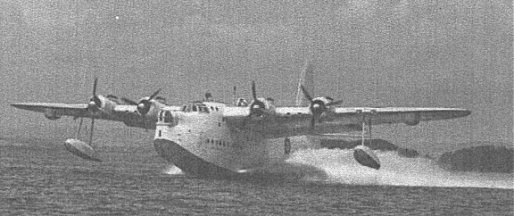
A Short Sunderland takes
off with its fifteen-man crew
under heavy skies for
a 15 hour lonely ocean patrol.
Jim
Patterson AG with 70 and 405 Squadrons
Something Different ??
It will do us (members of
Bomber Command) no harm to be reminded occasionally that there were other
Commands, other aircraft, other airfields, during the war and, that though
our own dear Bomber Command got most of the publicity, very good work was
quietly being done by the men and machines of Coastal Command. Operating
from odd locations, and leading the life of part airman, part seaman in
the big flying boats, a considerable number of AGs sweated out their war….so
different to ours.
In Northern Ireland is Loch
Erne, and from its waters rose and landed the Sunderlands of 422 and 423
Squadrons RCAF. The base was Castle Archdale, and even today in Northern
Ireland, many are the wrecks and remnants of some of the aircraft that
came to grief during 1941 to 1945, and sadly too are the neat well-kept
graves of those who fell.
My friend, James Stewart,
was brought up in the area of Loch Erne and has taken a very keen interest
in flying from Archdale during the war. He has access to much information
about aircraft casualties that may be of interest to those of our Air Gunner’s
Association who flew out of that lovely place.
Being in such close proximity
to the Republic of Ireland, it is inevitable that many of its citizens,
then neutral, would see and follow the goings and comings of the big flying
boats, and some of these actually ended up intact or in pieces in the Republic.
Forced landings and crashes in these circumstances resulted inglorious
sprees of “scrounging” by the natives, and many a scrap dealer made a handsome
living out of the pickings. Today, despite the “Troubles”, cross boarder
visits are possible to various sites where wreckage etc., is still on the
ground.
James Stewart is friendly
with members of the Ulster Aviation Society and they have provided some
of the details of various aircraft incidents, augmented by records from
the Air Historical Branch, and RAF Museum, and through the good offices
of another enthusiast, John Quinn, is able to get copy reports from the
Irish Army on some of the crashes.
James has supplied detail
of Sunderland crashes from December 1941. Members of 422 and 423 Squadrons,
who want to have a question and answer session may do so by mail with James
Stewart at the following address.
6 Winters Court, Hospital
Road,
Omagh, County Tyrone,
N. Ireland. BT79 0EE.
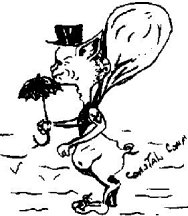
Sketch of Coastal Command
Gremlin can still be
seen on a brick wall in
Castle Archdale.
Don
Macfie
Don has sent us an interesting
piece of work. All through his service career Don kept a daily diary and
he has collated these pages with the pages of a book on the Battle of the
Bay of Biscay. Don did many patrols over the Bay with 423 Squadron and
then with 422 Squadron during the time line of the book. The author describes
conflicts over the Bay and Don’s diary adds flesh to the stories showing
that other aircraft were there and sometimes listening to the action on
their aircraft radio.
THE BATTLE OF THE BAY
By Norman L. R. Franks,
1986.
ISBN 0-7183-0602-3
“Following the fall of France
in 1940, Germany was able to take over and develop the important naval
bases along the French West coast that overlooked the mighty Bay of Biscay.
Beyond the Bay lies the Atlantic and the routes to America and South America.
From the Brest Peninsular in the North the Biscay coast line stretches
some 500 miles south-east and then south to Bayonne where it joined the
northern coast of Spain. The Spanish coast runs westward for 400 mile to
Cape Ortegal, Coruna and Cape Finisterre.”
As well as a concentration
of Submarine ports on the Bay, enemy fighter squadrons also became evident.
Coastal Command, which, before the fall of France, had been concentrating
on the North Sea, was suddenly faced with an impossible task.
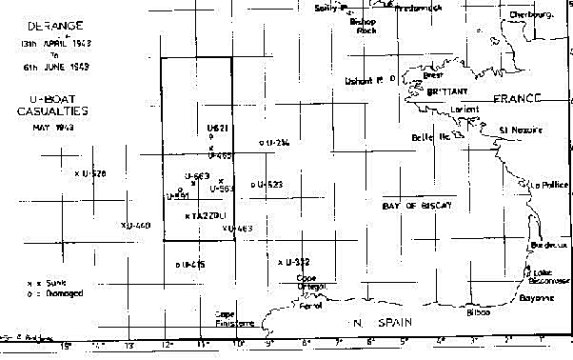
This work has been returned
to Don for later placement in a Museum. Thank you Don in helping keep the
memory of this corner of the war and the resulting sacrifices, alive.
From
Don’s diary 9/2/43
Take off 9:00 am on an A/S
patrol (in the Bay). Weather was squally and didn’t see anything but a
big surface raft with nothing on it. It is supposed to be a German decoy
anchored for us to home in on as bait for Folk Wulfe Condors to blast us
with cannon. I guess the weather was too bad for him.
We picked up six sighting
reports from other a/c of which two were attacked. Also heard an S.O.S.
from a Wellington being attacked by four JU 88s. Wellington shot up bad,
some of the crew wounded, but three Beaufighters intercepted and shot all
the 88s down. Sure interesting being on the wireless set. You listen to
all that goes on from Iceland to Gibraltar.
Richey (navigator) was a
little off on the way home and we ended up on the South coast near Portsmouth.
We were a couple of hours late when we got back and had only 280 gallons
of fuel left. S.E. brought us home. 14 hours away. Pretty tiresome.
Two of Don’s diary entries
sum up the boredom experienced on 15 to 16 hrs. single a/c patrols over
an endless ocean
2/6/43 . Another
trip. 15:15 hrs
15/7/43 Another Bay
of Biscay trip. Nice weather, nothing seen. Pretty “binding”. No mail.
DITCHING
IN THE BAY
Don Wells second pilot –
Jacques de le Paulle’s crew.
A little before nine my place
as co-pilot was taken by Romeo Freer and I went down to the ward room which
was empty of other crew members. My hand never reached the chocolate for
at that instant I heard the sound of an engine backfire.
My head whipped around towards
the right from where the noise had come from and I saw, with a terrible
numb sensation, that the starboard outer engine had a white hot fire burning
in the air intake below the engine.
Acrid fumes came through
the wing root and something told me not to panic and that our Engineer,
Ken Middleton, would soon have the fire extinguished, and we would be able
to return to base on the remaining three engines. He was looking at me
and, seemed about to say something, when a tremendous explosion rocked
the aircraft. I was knocked backwards.
The starboard engine was
hanging down from the wing root and was covered in oily smoke and flame.
As I watched in some awe the engine broke loose from its mountings and
fell towards the sea, taking the float and a good bit of the wing with
it.
With my shoulder braced against
the wardroom door frame I felt the crash and almost immediate deceleration
from 100 miles per hour to a stop. A great wall of water came crashing
through and our Sunderland came to a stop and started to settle by the
nose. We were 200 miles West of Cape Finisterre in the Bay of Biscay. It
seemed sure we would not stay afloat long.
Time seems to pass very quickly
when one is trying to get out of a sinking aircraft Heading for the back
door seemed like a long journey; the walkway was steep and slippery. Holroyd
and Joyce had opened the door and had untied the dinghy from its storage
space near the rear turret. With Mae West tied I jumped, hit the water
feet first and came up spluttering. The dinghy was near by and I clung
to it while I caught my breath.
Our first Navigator, Albert
Bolton, provided data (position report) while the Skipper was bandaging
his head. Albert had received a rather severe cut during the crash and
had lost quite a lot of blood. Our first aid kit provided the bandages
and the Skipper soon had him looking, from the nose up, like an Egyptian
mummy.
Earl Hiscox, our radioman
reported that an S.O.S. had been transmitted, but he had not had time to
receive an acknowledgement, and no map position had been sent for lack
of time.
There was no talk of food
because no one was hungry, and we spent the rest of the day trying to dry
our clothes and making preparations for the night. We worked hard during
the afternoon trying to get the two rafts tied together and putting out
some drogues, which would keep us lined up with the waves and prevent wave-top
tipping. We also released the baffles which were fitted below each dinghy
and which were intended to prevent the violent swinging to which these
rafts were prone.
When dusk came we broke out
the spray sheets and in preparation for the night put them over our heads.
The wind came up after dark and it began to rain. On top of that the waves
began to break over the sides of the dinghies, soaking every one to the
skin. Quite a few curses were heard during the lulls in the storm.
Everyone recovered their
spirits when the sun came up. The Skipper supervised the first issue of
rations. About six that evening, September 5, the wind came up again and
we took turns holding the connecting lines between the two dinghies so
as to prevent the rubber tabs on the sides from tearing off.
Someone thought they could
hear engines and Ralph Ruskin shouted, “There it is.” Someone ripped the
igniting tab from a flare and a red star shot up. The aircraft did not
alter course. Suddenly the Skipper shouted, “Douse that second flare; it
has six engines.” The only a/c that fitted the description was a Blohm
& Voss BV222, called The Viking, a German troop transport. What it
was doing in the Bay of Biscay we could not imagine.
The next day, September 6,
1943, our fourth day away from based, was uneventful until about four in
the afternoon, when, purely by accident an American Liberator came and
by and flew right over our heads at low altitude. We were delighted to
see the Liberator drop a parachute bag….a dozen oranges and three packs
of cigarettes, and a scrawled note that read; ‘DON’T GO AWAY, HELP IS COMING’.
An hour went by until a Squadron
228 Sunderland flying boat (F/L Armstrong) appeared. The wind had increased
and we could see that the landing with swells would be both difficult and
dangerous, however they made a fine landing. We were plucked from the sea
and the take-off was an experience which no one would want to go through
twice.
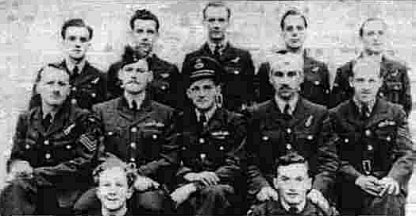
Jacques de le Paulle's
Bay of Biscay Crew
BR: David MacPherson,
Earl Hescox, Ken Middleton, Bill Holroyo, Roy Jollymore
MR: Art Joyce, Romeo
Freer, Jackques de le Paulle, Al Bolton, Don Wells
FR: R.M. Fisher, Ralph
Ruskin
Of the casualties on
422 Squadron, 65% are listed as buried at sea. In many cases the circumstances
are not known, only, “failed to return”. Their names live on through the
Runnymede Memorial in Surrey, England.
Interesting Search Pattern:
http://www.google.com/search?q=runnymede%20Memorial
On Friday 17th October
2003, Her Majesty Queen Elizabeth II,
rededicated the Air Forces
Memorial at Runnymede.
The rededication coincided
with the 50th Anniversary of
it's original opening
by the Queen in 1953
The Runnymede Memorial
Built by the Commonwealth
War Graves Commission
to commemorate the memory
of the 20,356 British and Commonwealth airmen of WWII
who have no known graves.
Designed by Sir Edward
Maufe
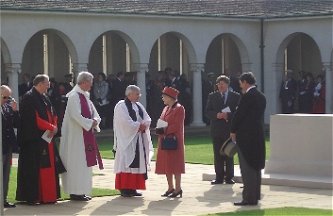
Re-dedication of Runnymede
Memorial by Her Majesty
Diary
of a Tail Gunner by John Gabay
taken from EYEWITNESS To
War
Special Edition to Military
History Magazine
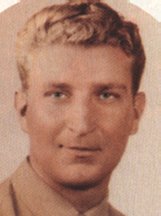
Gunner – John Gabay
8th USAF
Gelsenkirchen, Germany
11/5/43
(B-17 382 – Horrible
Hanks) Target: Ruhr Valley refineries. Temp –43 degrees FT.
Flight time 5:15: ET(time
over enemy territory)y: 1:35. Altitude: 28,000 feet.
We went over Holland and
immediately saw three Me 109s, later on we saw ten FW 190s, two JU88s one
ME 110, and then several more 109s. I fired at a 109 coming in at 6 o’clock…
Flak was very intense and pretty accurate. Our ship was hit several times,
two holes in left wing flaps, several in fuselage, severed oil line in
number three engine and bent the prop. Oil covered the ball turret and
wheels. I could hear pieces of flak hit – concussion diving the ship several
feet upwards…. The waist gunner got the bends. He screamed with pain. Now
the ME 109s moved in for another battle. My guns worked perfectly. I was
holding them off pretty good….our P-47s met us and scattered the enemy
fighters.. We lost one bomber in that last fight. Bombs went through the
wing of another ship but they made it back ok.
This was my first raid and
it was with an old crew. They had 24 missions and were uneasy to have a
rookie flying tail gun. But when we landed they all came back and shook
hands with me and said I did OK.
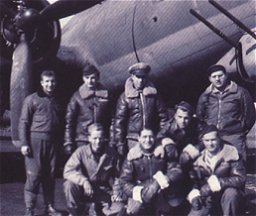
Crew of Lucky 13 – Gabay
far left back row
Frankfurt, Germany 2/8/44
(Passion Witch 11) Target: Heart of City –47 degrees FT 8:40 ET :4:00
Alt.: 27,500 ft.
….Flew at pretty high altitude.
As soon as we started our bomb run I saw a group of Me 109s at 6 o’clock
low and leaned up to keep an eye on them and in so doing, pulled out my
oxygen hose without knowing it. I passed out and hit my head on the armour
plate. But before I passed out I, I vaguely remember trying to plug the
end of the hose back where it belonged, but I just couldn’t reach it. I
thought it was hanging out the rear of the ship for several miles and I
kept trying to pull it back in. The Flight Surgeon said that a man could
only live for about ten minutes without oxygen at this altitude, but according
to the crew, they were trying to contact me for over twenty minutes. Bill
Geier (waist gunner) crawled back to the tail and found me slumped over,
no oxygen and my face purple. He gave me emergency oxygen and artificial
respiration as best he could. I started breathing again. When I came to
I started fighting with him but I had no strength…was groggy all the way
home. The crew said I was shooting at fighters but I don’t remember it.
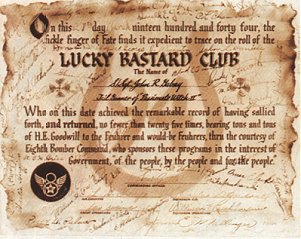
John Gabay’s Lucky
Bastard Club Certificate Signed by Squadron Members
John Gabay returned home
with a Distinguished Flying Cross and three Oak Leaf Clusters. In April
1945, the war’s last month, his 21 year old brother Eugene, also an 8th
Air Force tail gunner, was killed by flak on his 27th mission over Germany.
Back in New York City, John Gabay married and had 12 children. He died
in 1986, age 64.
Phil
Dubois
Phil sends the following
received from his friend, Ex-AG Harry McLean in UK.
CREWED UP
On 27th August, 1942, I passed
out from No.1 Air Armament School RAF Station Manby, in Lincolnshire. I
received my Sergeant’s Stripes and seven days leave, to report after to
Wing in Buckinghamshire.
Having been in the Royal
Air Force for just five months, and being aware that a wing was a part
of the Air Force structure, I thought that I had been selected for some
duty other than that of on a Squadron. My optimism was misplaced, when,
on reporting for duty, it was to find out that I was one of about 50 aircrew
who were on 26 Operational Training Unit, to prepare for joining Bomber
Command at the end of the course, in about ten weeks.
We gathered in a lecture
theatre, and were addressed by the CO, who told us that for the first week
we would be concentrating on other aspects of training relating to our
perspective trades, and that by weeks end were expected to have organized
ourselves into crews. Those who had not been placed would be crewed up
by Himself.
I noticed that most of the
pilots were Sergeants, two were Pilot Officers, and there was one Wing
Commander. There were a few Colonials who were serving with the RAF, and
one Pilot Officer, a Navigator, who was black. I believe that he was from
St. Lucia, and he was the only coloured person I met during my service.
He, F/O Etienne, was KIA on 5th March, 1943.
I did nothing the first day
but on the third day thought I might try to find a pilot. I asked one of
the P/Os but he had already made up a crew. This disheartened me somewhat.
Next morning at coffee this same officer asked me if I had found a Pilot.
I was about to say that I had not, when I felt mischievous and replied,
“Yes, I have. I’m flying with the Wing Commander.” On further questioning
I added that I had asked the Wing Commander and he said he would be glad
to have me. At the gathering after lunch this same P/O came to me and said,
“The Wing Commander wants to see you.”
My God, I thought. You’ve
done it now Harry. I saw the Wingco, gave him the smartest salute I could
manage and said, “I’m Sgt. McLean, Sir. I have been told to report to you.”
“Yes”, he replied. “I believe you are looking for a Pilot. If I will do
for you, then you will do for me.”
That is how I became gunner
to the Commanding Officer of 428 Squadron, RCAF.
Wing Commander Earle was
a grand chap, one who can genuinely be called, ‘One of Natures Gentlemen’.
He was well liked by the Canadians and sadly missed when promoted to Group
Captain and left us in February 1943. He did two Ops from Dalton, occupying
the astro-dome. He had previously been flying Fairey Gordons in the Middle
East, and found the Wellington difficult, partly due to his eyesight not
liking the English skies, and partly as he was not a tall man.
After Christmas, 1942, there
had been a heavy snow in Northern Britain followed by winds. Winco was
getting his night flying hours in, just he, Sgt. Reynolds, our WOP, and
myself. We had done a few touch-downs and take-offs. I had got used to
seeing the airfield lights fall away behind us as we gained height. On
this occasion, after falling for a while, the runway lights started to
gain height. We were losing height when we should not have been. I became
worried as there was a railway line across Yorkshire for some miles on
a high embankment. Getting close to the turret side window, I could see
the bushes, from which the snow had blown, standing out clearly above the
snow covered ground. We were very low. What to do? How could I, with six
months service, tell a Wing Commander with 15 years service, how to fly
his aeroplane?
I had to do something, so
I called, “Skipper. Aren’t you a bit low?”
There were a couple of seconds
silence, before he replied, “Jesus Christ”, and up we went.
Yes he was a great chap and
deserved to become Air Chief Marshal Sir Alfred Earle GBE, CB, etc., Deputy
of the Defence staff to Lord Mountbatten, and Director General of intelligence
after leaving the RAF.
He died in 1990. The world
is sadder for his going.
British
Monument for Canadian Air Gunner Andrew Mynarski VC.
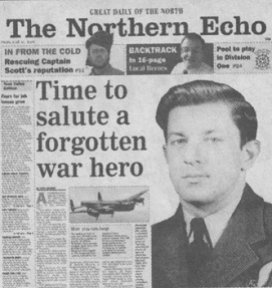
British campaign to honour
Andrew Mynarski VC, quarter of the way to goal.
The British newspaper, The
Northern Echo, wants to erect a bronze statue more than two metres high
of Andrew Mynarski V.C. at the Teesside International Airport, formerly
RAF Middleton St. George where Mynarski’s final wartime flight originated.
Its campaign is called The Forgotten Hero Appeal
Peter Barron, Editor of The
Northern Echo, said about 10,000 of the 40,000 pounds needed poured in
on the very first day of the campaign to honour Canadian Andrew Mynarski,
whose ultimate act of bravery in the Second World War led to a posthumous
Victoria Cross….. “As well, the local authorities, and the six local councils
here, have pledged 1,000 pounds each. It has really been positive here.”
The campaign has received
support from British Prime Minister Tony Blair, Manitoba Premier Gary Doer,
and the Winnipeg Free Press, among others.
Andrew Mynarski joined the
RCAF in September 1941. He began training as a Wireless Air Gunner but
graduated as a straight Air Gunner, and in April 1944 joined 419 (Moose)
Squadron A Middleton St. George in the UK. On his twelfth operational
sortie, on June 12, Mynarski was mid upper gunner on Lancaster KB76, ‘A-Apple’,
detailed as one of the force dispatched to attack the marshalling yards
at Cambrai, France. It was a low level raid, briefed to bomb at 2000 feet.
The run into target was made through a veritable hail of flak, then before
reaching the objective Mynarski’s Lancaster was jumped by a Ju88 Night
Fighter, which bore in from the port beam raking the bomber with cannon
shells, and followed up with an equally devastating attack from below and
astern.
Both port engines failed
and a roaring fire erupted in the rear fuselage, just to the rear of Mynarski’s
turret. In the rear turret F/O George (Pat) Brophy had taken the brunt
of the attack having his turret’s hydraulic lines shattered, leaving him
with only his manual winding handle with which to rotate his turret. His
Skipper, having checked the uselessness of the controls, and realizing
the dangers of the burning wing, ordered the crew to bail out. Brophy wound
his turret towards the beam – then the winding handle sheared: he was trapped,
helpless without outside aid.
Mynarski, obeying his pilots
last order, climbed down from his turret and was about to go forward to
the escape hatch when he glanced to the rear of the fuselage and realized
Brophy was still in the turret. Despite the raging fire, unhesitating,
Mynarski scrambled through the flames and began beating against the jammed
turret doors in an attempt to get them moving. His flying clothing, already
saturated with hydraulic fluid from the ruptured systems pipe line, burst
into flames, but he continued to hammer against the turret doors.. Brophy
could see Mynarski’s burning clothing and yelled for him to get out of
the bomber before it was too late. Reluctantly Mynarski left his friend
and made his way to the escape hatch. Before diving through the open hatchway,
Mynarski straightened up, faced the rear turret, and saluted Brophy as
a sincere gesture of farewell; then, with his clothing and parachute a
mass of flames, Andrew Mynarski jumped. At such low altitude and in his
perilous physical state, he stood no chance of survival, and plunged to
the earth.
The crippled Lancaster exploded
on impact; yet by some miracle, Brophy’s turret was flung clear of the
burning wreckage, and he survived, along with the remainder of the crew.
Only after the war when Brohpy was repatriated to England from Prisoner
of War camps was Mynarski’s story put before High Authority. On October
11, 1946, Andrew Mynarski was awarded a posthumous Victoria Cross – in
attempting to aid a fellow Gunner, he had jeopardized his only hope to
personal survival, and this utterly selfless action cost him his life.
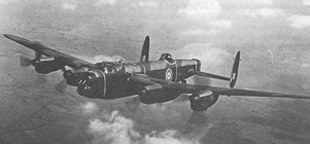
This restored flying Lancaster
at Hamilton, Ont. has been designated KB726 VR-A
The Mynarski Lanc.
When the Ex-Air Gunner’s
Association of Canada was formed in 1983, at the request of the Association,
Mrs. Holowaty gave her consent to allow us to do what we could to help
perpetuate he brother’s memory.
F/O Brophy remembers that
Andrew had found a four-leaf clover shortly before they took off for the
Cambrai raid from Middleton St. George, County Durham, in North England.
Andrew gave it to him and said, “you take it.”
Brophy has said, “I’ll always
believe that a Devine Providence intervened to save me because of what
I had seen, so that the world might know of a gallant man who laid down
his life for a friend.”
Donations in Canada can
be sent to the Air Force Heritage Fund
1 Canada Air Division,
Winnipeg, MB. R3J 3Y5
Tax receipts will be
issued.
Write Andrew Mynarski
Statue on the memo line.
THAT'S
ONE TERRIFIC TIGER
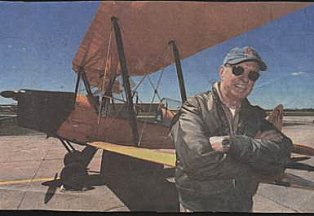
Bob Laidlaw touched down
in Regina, Sk. June 25, 2004
Bob Laidlaw, a 78-year-old
pilot from the U.S. with his 62-year-old DH-82C Tiger Moth biplane. Laidlaw,
a former Second World War pilot, is flying the restored plane from California
to Toronto, where it will rest in a museum.
Bob learned to fly on Tiger
Moths at Oshawa, Ont. in 1944. attended #32 FTS at Moose Jaw, Sk. And went
overseas to fly Mosquito a/c. He had a desire to again fly a Tiger Moth.
He found one partially restored in Alberta in 1997. Most of the paper work
on this a/c had been destroyed in a fire in the Moose Jaw control tower
in the late 1940s. It had been built in 1942 and trained pilots in Virden
and Neepawa. It was then sold to the Moose Jaw flying Club. It languished
on a farm near Assiniboia, until bought by an Albertan and partially restored.
Bob has donated the Tiger
Moth to the Toronto Museum. Go to the Museum’s web site for more information:
http://www.torontoaerospacemuseum.com/tigermoth/
Some Wireless Schools trained
Wireless Air Gunners on the Tiger Moth.
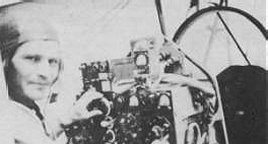
Felton tuning up. #3 Wireless,
Winnipeg, Man. Crowded cockpit.
(Ed. A personal experience
at #2 Wireless School: When I carried out the first of three flying exercises
it was a complete washout. It was a listening out exercise and when settling
in to the cramped cockpit I accidentally kicked out the plug to my ear
phones. After the flight I was sitting in the hangar feeling sorry for
myself and waiting for the axe to fall when a young Pilot Officer Pilot
comes up and says, “Lets go, your are doing the third exercise.”
Who was I to argue with
an officer! We sat on the taxi strip waiting for a line of Ansons to take
off. I guess the pilot must have had a date that night as he was in a hurry
to get the assignment finished. He passed me back a position report and
said, “send this in.” I did and, because were still on the ground, got
great reception. We finally got take-off clearance and the pilot flew directly
to position report two and then three. All went well.
Back at the hangar a Warrant
Officer approached and said, “You failed your first exercise Moyles, so
you will have to go back to the next class.” This was devastating as it
would mean leaving all the chaps with whom I had trained. I blurted, “But
Sir, I have just completed #3 successfully. Ask that officer over there.”
After discussion with the pilot, he returned and said, “Ok, I guess you
have completed your flying exercises.”
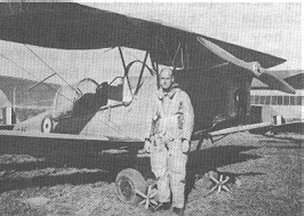
Fred Burnyeat with Tiger
Moth
Calgary, 20th Entry, Sept.15,
1941.
Then there was the time a
Tiger Moth returned with a cow’s horn wrapped around the trailing aerial…but
that is another story.
CORRESPONDENCE
Dear John and Doreene,
together with my girl friend
Melanie Patten I write a book about the largest
airborne Operation of WW
2 and was appreciated to find the article "I FLEW
BACK TO SEE DUISBURG DIE"
by William Troughton on your homepage. We would
like to get in contact with
anybody who took place in the raids and also
would like to get some photographs
or documents for our book.
Sincerely yours
Melanie Patten &
Harald Molder
Duisburg / Germany
haraldmolder@hotmail.com
Harald Molder
Am Finkenacker 30
47259 Duisburg
Germany
Again all the best to the
members of RAF Bomber Command
(Ed. Harald is referring
to article in March 2004 Page. Check your log books, were you at Duesbury
Oct. 14/15/16/1944? If so drop a line to Melanie and Harald)
Charley Yule
John: This is the
message which I received from Matt Poole in Wheaton, MD USA, and
mentioned to you on the phone. Thought there might be a small article
for SHORT BURSTS which might possibly stir memories. If not - file
it!
Dear Charles,
On the Internet I saw March
"Short Bursts", the newsletter of the Ex-Air Gunners, and I was saddened
to learn of the passing of Vern Donnelly of Winnipeg. I corresponded
with Vern several times in the 1990s at around the time of his visit to
the Far East with the Canadian veterans group. My mother's first
husband, Sgt. George Plank, flew with 159 Squadron in early 1944 and was
shot down and killed over Rangoon on 29 Feb 1944 (hence, my e-mail address).
Through my years of research
into the action I learned much about 159 Squadron and befriended Ivor Smith
of Australia. Ivor's uncle, Arthur Williams, was lost in perhaps
159 Squadron's most well known incident -- the downing of C-Flight's "Wottawitch"
over southern Burma on 31 January 1945. S/Ldr Bradley was the skipper.
Although six crewmen bailed out successfully, Arthur was never again seen
after he exited the bomber.
Of course, this incident
is so famous because of the horrific ending which befell four of the crew.
Bradley and his navigator, Allan Jeffrey, were sent to Rangoon Jail and
survived the war, but the four sgts/flight sgts, technical specialists
all, were ultimately beheaded after terrible torture. Stanley Woodbridge,
the last to die and the one with the most technical info, was posthumously
awarded the George Cross in 1947 or '48.
Anyway, Ivor put me in touch
with Vern, who also flew with C Flight of 159 Sqn. During his visit
to Rangoon and Singapore, Vern took photos of relevant names on the Singapore
Memorial and graves in Rangoon and Taukkyan war cemeteries. It was
a very nice gesture. He also sent me a videotape.
I have notified Ivor of Vern's
passing.
Now, I have a question for
you. Just today I received an e-mail from ex-159 Squadron instrument
basher George Barker-Read of the UK. He asked the following:
"Was there a Scottish Observer
named 'D.R.'(dead reckoning) Yule ?"
Minutes after reading George's
question, I walked into my bedroom and my eyes stopped on your name at
the bottom of Vern's obituary, which I had printed out last week.
COULD IT BE?, I thought. I'd never recognized the name "Yule" before
in my 159 Squadron research, and now moments after I'd been asked about
a D.R. Yule, I recognized your name.
Are you the Dead Reckoning
Yule remembered by George? He was with the squadron from the formation
of the squadron until past the war's end.
If you are he, I'd like to
surprise George with the news, and then I'll give you his e-mail.
If you were with 159 Sqn,
what was your assignment? I don't see you in aircrew listings, on
initial inspection.
Thanks, and best wishes,
Interesting
sources of used out of print books
Hi John,
I found 13 copies
of the "Sunderland at War" book by searching
www.ablebooks.com
, most in the UK, at the following link:
http://dogbert.abebooks.com/servlet/SearchResults?an=Bowyer&imageField.y=6&i
mageField.x=51&ph=2&cmid=hp-search-form&tn=Sunderland+at+War&sts=t
Nine copies of "Sunderland
Squadrons of World War 2" showed up on this
search and I'm going to
order a copy for myself from one of them.
http://dogbert.abebooks.com/servlet/SearchResults?&ph=2&imageField.y=5&image
Field.x=37&tn=Sunderland+Squadrons+of+War+War+2&cmid=hp-search-form&an=Lake&
David.
Branch
Reports
Northern Alberta Branch
Ted Hackett
The members of the Northern
Alberta Branch got together with the local Wartime Aircrew Association
for a barbecue on June 09, 2004. The affair was held at the Pioneers
cabin in Edmonton, a nice little spot overlooking the North Saskatchewan
River with a nice view of the Edmonton skyline. There was a good
crowd in attendance from both organizations and they enjoyed a fine dinner
of either steak or chicken with all the trimmings, washed down of course
with some fine wine. The weather was nice unlike last year when some rain
kept us indoors for part of the evening. This was the second year the barbecue
has been held and a quick show of hands indicated that everyone would like
to hold it again next year.
A survey of the members
present indicated that we should have a good attendance at the “Salute
to Air Gunners” in Nanton, Alberta August 14th. We sent a cheque
to Nanton this month to help in the purchase of the Boulton-Paul mid-upper
turret which, with the help of our friends in Calgary and others, they
were able to obtain.
Northern Saskatchewan Branch
President “Smokey” Robson
reported that their June luncheon was well attended.
Air Gunner Members travelling
across Canada this summer be sure to check Branch meeting dates as listed
in this Page and plan to attend some of these luncheons.
Restoring Handley Page
Hampden
In the June Issue we recorded
the restoration of Hampden P5436. Here are some follow-up pictures.
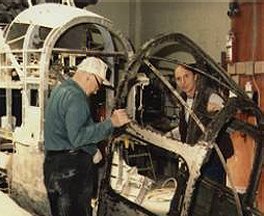
Jerry Olson and Fred Gardham
(cap) working
On Nose section in Jerry’s
garage, Vancouver.
Jerry located the a/c in
Sanaich Inlet, BC.
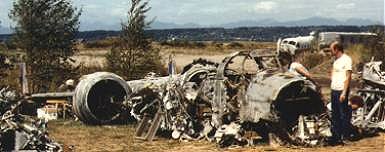
Where do you start?
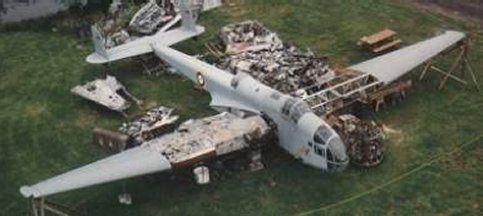
Building to mate starboard
main frame which was not
damaged when a/c hit water
and jackknifed.
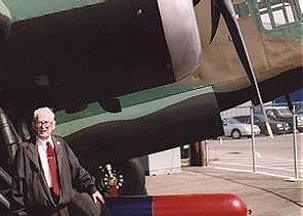
Fred Gardham at Starboard
undercarriage.
OBITUARIES
CRAIG, GRANT. G.
#0920, EDMONTON, AB: We have been advised by Ted Hackett of Grant's
passing on June 24th, 2004 after a lengthy illness. He enlisted October
1942 in Ottawa and was trained as a WAG/NAV. Attended #4 W/S at Guelph
and #6 B&G Mountain View. He flew on Ops with #45 (RAF) Atlantic
Ferry Command, flying in a variety of aircraftr to the UK, Africa, Italy
and India, and was commissioned as J38268
Editors
Report
In the May 2004 Page we announced
the Air Gunner’s Day being hosted by the Nanton Museum. I have had a number
of phone calls from members who hope to attend this ceremony. Here is part
of the letter of invitation:
“Our “Salute to the Air
Gunners” will take the form of a luncheon in the museum followed by various
tributes to the Air Gunners. As part of the program we will be unveiling
a commissioned painting by well-known aviation artist John Rutherford depicting
Sgt. Engbrecht and Sgt. Gillanders in action. Following the ceremonies
flypasts of various vintage and modern aircraft will salute the air gunners.
For additional information
regarding our museum please visit www.lancastermuseum.ca and in particular
our “Past Special Events” section that documents our numerous successful
special events of previous years and our “Air Gunners” section.
Please let us know if you
will be able to join us on August 14th. I can be reached through the addresses
listed or directly by telephone at (403) 646-2681 (evenings).
Yours truly,
Dan Fox, President
Mailing Address
PO Box 1051, Nanton, Alberta Canada T0L1R0
Telephone
Museum: (403)
646-2270
Fax: (403) 646-2214

Business correspondence:
nlsoffice@lancastermuseum.ca
Inquiries and Information:
nlscurator@lancastermuseum
ca
At last report there will
be members attending from Vancouver, Edmonton, Calgary, Winnipeg, and Regina.
There will be NO SHORT
BURSTS WEB PAGE newsletter in August. Hopefully we will have full coverage
of the Nanton Day in the September Page.
Keep well.
Cheers, John and Doreene
Moyles.
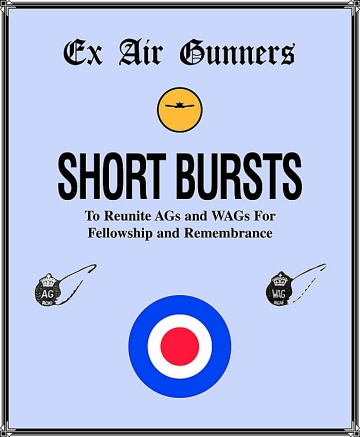

![]()
![]()
![]()
![]()
